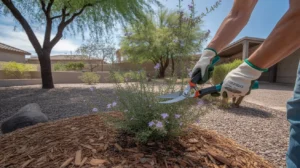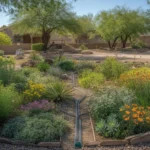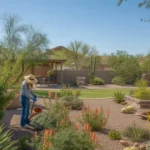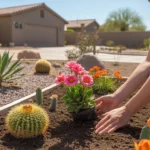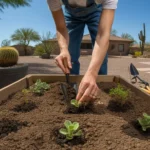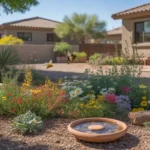Spring has sprung in Chandler, and that means it’s time to wake up your garden from its winter slumber. With our mild desert climate, a little TLC goes a long way in getting your yard ready to burst with color and life. These simple spring gardening tips will help you effortlessly revive your Chandler landscape without breaking a sweat.
Give Plants a Fresh Start with Pruning
One of the first tasks to tackle in spring is pruning back any winter-damaged or overgrown branches on trees and shrubs. This encourages healthy new growth and keeps plants looking tidy. In Chandler, late February to early March is the ideal window for most pruning.
Focus on removing any dead, diseased, or crossing branches first. Then shape plants lightly to maintain their natural form. Avoid shearing shrubs into tight shapes, as this can stress plants in our intense heat. For flowering shrubs like Leucophyllum (Texas sage), wait to prune until after their spring bloom cycle finishes.
Pruning desert trees like mesquite and palo verde is also best done before summer. Just be sure not to over-prune, as these trees need some leaf cover to protect trunks from sunburn. If in doubt, consult a certified arborist who knows how to properly thin desert tree canopies.
Wake Up Soil with Compost and Fertilizer
Desert soils tend to be lean and low in organic matter. Giving planting beds a boost of nutrients in spring helps fuel robust growth and flowering. Aim to work in a 1-2 inch layer of compost across beds, gently scratching it into the top few inches without disturbing plant roots.
For an extra kick, follow up with a slow-release fertilizer formulated for desert plants, like a 5-10-10 blend. This provides a steady supply of nutrients as plants rev up growth in spring. Always water deeply after applying fertilizer to help it soak down to roots.
When fertilizing desert-adapted plants, a little goes a long way. Resist the urge to overdo it, as this can burn roots and promote excessive growth that can’t handle summer heat. For most plants, one application in spring and another in fall is plenty. For more tips, see our guide on How to Fertilize Desert Plants in Gilbert.
Refresh Beds with New Plantings
Spring is hands-down the best time to plant in Chandler. Warm soil temps spur fast root growth, while mild air temps are easier on new transplants. Take advantage of prime planting conditions to fill in bare spots and add pops of color.
For low-fuss curb appeal, you can’t beat native and desert-adapted perennials. Penstemons, salvias, and desert marigold offer months of vibrant blooms with minimal upkeep. For a drought-tolerant groundcover, try hardy Myoporum parvifolium or Dalea greggii. Both form dense mats that can handle light foot traffic.
If you’re starting a new bed or revamping an old one, consider installing a raised bed that’s built to last in our desert conditions. Raised beds are ideal for improving drainage in caliche soils and corralling rich planting mix. They also bring plants closer to eye level for easier tending.
Mulch, Mulch, Mulch!
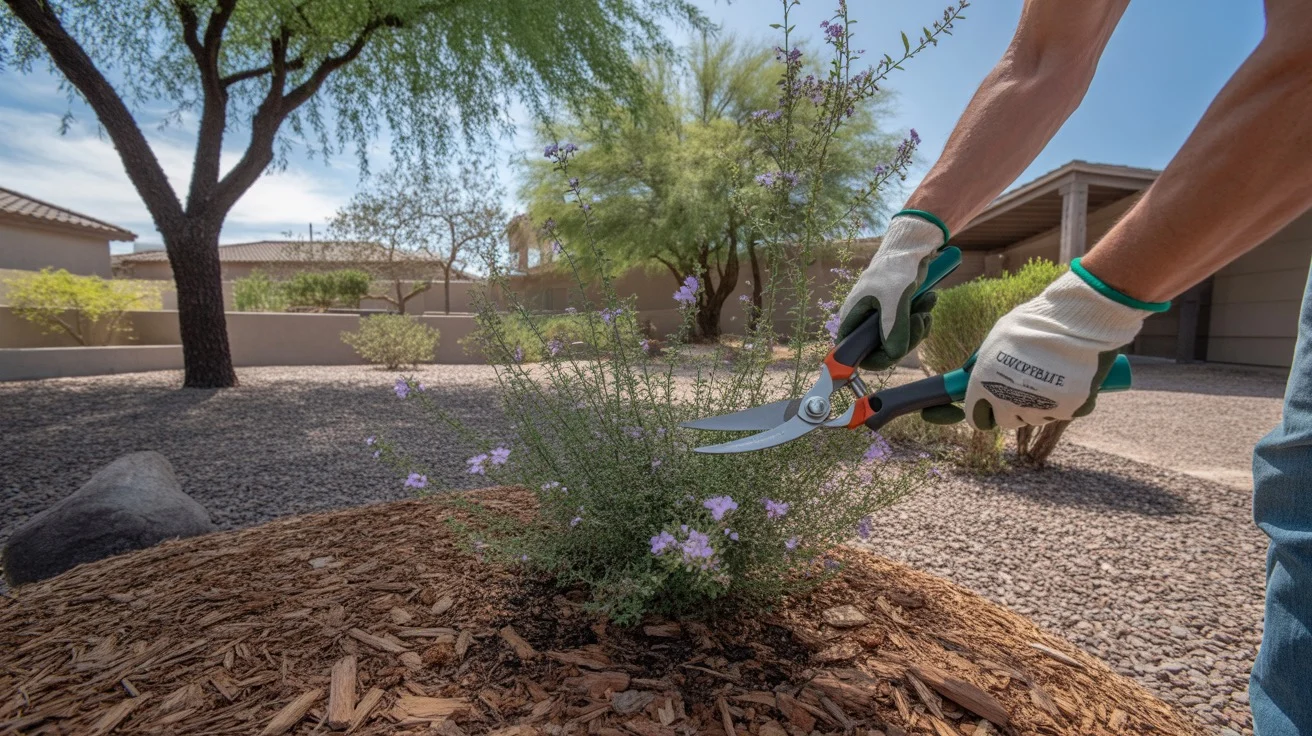
Once you’ve finished planting, top beds with a 2-3 inch layer of organic mulch, like shredded bark or wood chips. Mulch is a multi-purpose workhorse that suppresses weeds, moderates soil temps, and conserves moisture so you can water less. As it breaks down, it also adds organic matter to soil.
Avoid mounding mulch against plant stems or tree trunks, as this can trap moisture and invite pests and disease. Instead, pull mulch back a few inches to create a donut-hole around the base of plants. Refresh mulch as needed to maintain a depth of 2-3 inches.
For a more decorative look, you can top dress beds with a layer of inorganic mulch, like crushed granite or river rock. Just be sure to lay a permeable landscape fabric underneath to keep rocks from migrating into soil. Inorganic mulches last longer but won’t enrich soil like organic ones do.
Calibrate Irrigation for Longer Days
As temperatures climb and days grow longer in spring, plants kick into active growth and need more moisture. Now’s the time to ramp up watering frequency to keep pace with increasing demand.
If you haven’t already, consider installing an automated drip irrigation system to take the guesswork out of watering. These systems deliver moisture directly to roots, minimizing evaporation and waste. They’re also easily customized, so you can fine-tune watering for each zone’s specific needs.
When setting your irrigation schedule, always water deeply and less frequently to encourage deep root growth. Aim to soak the top 8-12 inches of soil, then let it dry slightly between waterings. Watering times will vary based on your system’s output, so some trial and error may be needed to dial it in.
Keep an Eye Out for Pests
Warmer weather can also wake up hibernating pests like aphids, whiteflies, and spider mites. These sap-suckers can quickly infest new growth, causing leaves to yellow, curl, or stipple. Catch them early before they get a foothold.
Regularly inspect plants, especially on the undersides of leaves where pests like to hide. A strong spray of water can dislodge light infestations. For heavier outbreaks, try an insecticidal soap or neem oil, being sure to fully coat leaves.
Avoid broad-spectrum insecticides that can harm beneficial insects too. Ladybugs, lacewings, and other predators will help keep pest populations in check naturally. You can even buy these “good bugs” from garden centers to release onto plants for an all-natural defense squad.
Get a Handle on Weeds
Spring also kicks off weed season in Chandler. Catching them early before they flower and set seed can dramatically reduce future crops. After winter rains, watch for weeds popping up in gravel and pavement cracks.
For small weeds, a quick scuffle with a hoe or string trimmer may be all you need. Larger weeds may require hand-pulling or spot-treating with an herbicide. If using the latter, shield nearby plants and apply on a calm day to prevent drift.
The best defense is a thick layer of mulch to deny weed seeds the light they need to germinate. Weed barrier fabric can also help in gravel areas and under pavers. Just be sure to overlap edges and secure tightly so crafty weeds can’t find a foothold.
With these simple spring gardening tips, your Chandler yard will be primed for a beautiful growing season. By staying on top of basic maintenance now, you can relax and enjoy the lush desert paradise right outside your door. Happy planting!

